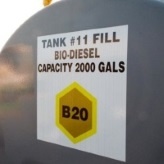Fixing Problems With Water In Fuel Tanks
Water is the enemy of stored fuel, the tanks it’s stored in, and the equipment that uses it. Fuel storage rules that used to allow for “allowable”...
2 min read
Erik Bjornstad : Jan 22 2016

The nature of stored fuel being what it is, there are thousands of storage tanks across the land with fuel that hasn’t been checked in a while. This fuel is assumed to still be problem-free and viable. Unfortunately, this turns out not to be the case more than a few times.
 If you have stored fuel, and you don’t check it on some kind of regular basis, that moves you into the higher-risk category for fuel problems.
If you have stored fuel, and you don’t check it on some kind of regular basis, that moves you into the higher-risk category for fuel problems.
Some people think advice to check your fuel regularly means you have to lay out significant time and money to run all sorts of tests on the stored fuel, verify its ASTM properties, etc etc. That's not necessarily the case most of the time.
The best practice recommendation is you should be checking at least for microbe presence and water bottom in the tank on a monthly basis. Your primary goal is to detect fuel microbes before they become a problem. It doesn’t take long at all for microbes to establish a presence in a storage tank and multiply to voluminous numbers quickly. Especially where a water phase is present - Hence the need to check for both microbes and water on a monthly basis.
And in comparison to doing nothing at all (which is the norm for many), even a simple visual check is better than complete inaction. The human senses are sort of underrated for detecting problems. Many times, drawing a fuel sample and noting simple changes in how the fuel looks can be a simple first step towards uncovering a broader problem with the fuel.
Some of you are saying “I don’t need to do this. I don’t have a water problem.” Sure you don’t. That’s what everybody thinks. Water buildup is a universal phenomenon, which makes microbes in fuel tanks a universal phenomenon.
Water can accumulate in a fuel storage tank through simple natural condensation of water vapor from the air. And can you control all the other ways water gets into storage tanks? Can you control if someone delivers water in your fuel drop? What if someone leaves the lid cracked on an above ground tank and it rains? These “water ingress” methods happen a lot more often than you would suspect.
Not keeping an eye on your stored fuel is asking for trouble. Your monthly fuel check should include a visual inspection of fuel for any signs of unusual change, combined with checking for water presence.
None of these recommendations are complicated but they’re all important if you want to avoid stored fuel problems.
Water is the enemy of stored fuel, the tanks it’s stored in, and the equipment that uses it. Fuel storage rules that used to allow for “allowable”...

Getting quality fuel that’s in-spec only means you're halfway home when you're considering stored fuel quality. The storage tank you put it in has...
The amount of diesel fuel storage for emergencies is pretty vast. While the exact amount of it is unknown (partially because that volume varies from...